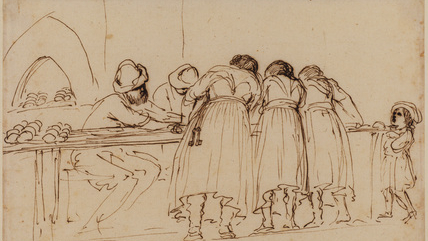
Guercino: Mind to Paper
22 February – 13 May 2007
“Heart-stopping drawings of life and myth” Independent on Sunday
“Extraordinary technical and stylistic versatility ” The Times
Giovanni Francesco Barbieri (1591-1666), nicknamed Guercino (“squinter”) after a childhood incident left him cross-eyed, is regarded as one of the most significant Italian artists of the Baroque period. A prolific and fluent draughtsman who was known as ‘the Rembrandt of the South’, he was hailed for his inventive approach to subject matter, his deftness of touch and his ability to capture drama and movement. This exhibition reflected the artist’s extraordinary technical and stylistic versatility, and was the second joint exhibition to be organised as part of the Courtauld Institute of Art’s ongoing collaboration with the J. Paul Getty Museum, Los Angeles.
Guercino spent almost his whole life close to his birthplace of Cento near Ferrara, and in Bologna, but his reputation was cemented in Rome while he was working for the court of Pope Gregory XV between 1621 and 1623. After returning to northern Italy, he ran a busy and successful workshop where he made hundreds of paintings over the course of his career. His works were sought after internationally but he turned down invitations to become a court artist in both London and Paris.Guercino is celebrated as one of the most naturally gifted and versatile draughtsmen of his age. The drawings in the exhibition have been specifically chosen to demonstrate his remarkable technical and compositional ability as well as his wide-ranging choice of subject matter. They include a rare large study of a male nude, an imaginary landscape, a caricature, a number of highly appealing informal scenes from everyday life and exploratory studies for large painted compositions. Guercino’s early biographer Carlo Cesare Malvasia (1616-93) recorded that the artist was ‘affectionate of the poor, who flocked around him whenever he left his house, as if he were their father; he enjoyed conversing with them’. His sympathy for a variety of human situations is particularly apparent in such scenes as Interior of a baker’s shop, a scene humorously observed from life.
Supporters
- Friends of the Courtauld Institute of Art
- Guercino Supporters Circle: Agnew’s; Jean-Luc Baroni; Katrin Bellinger; Christies; Columbia Foundation; Day and Faber; Kate de Rothschild; Dickinson; Hazlitt Gooden & Fox; Italian Cultural Institute; The Matthiesen Foundation;Flavia Ormond Fine Arts; Thomas Williams Fine Art Ltd





